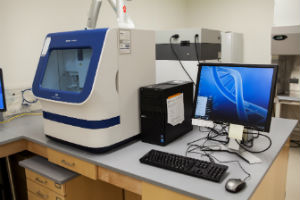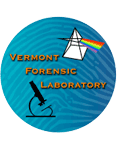DNA typing has been used at the Vermont Forensic Laboratory since 1991. The methods have changed over the years, but the basic concept remains the same.
DNA analysis performed at the laboratory involves the use of non-coding areas of DNA called short tandem repeats (STRs) to differentiate the DNA of one individual from that of another individual (except for identical siblings). There is considerable variation in the number of repeat units that may be contained at a particular location (or locus) of DNA. Since individuals have two copies of DNA, one inherited from each parent, the actual combination of types across the 23 locations examined provides distinguishable profiles for each individual. Currently the lab uses a method called the polymerase chain reaction (PCR) to make many copies of small amounts of DNA so that they can be characterized. The results are called a DNA profile.
A DNA profile obtained at the VFL provides investigative information only by comparing it to one or more known (reference) DNA profiles. The locations tested do not provide information about the physical features, age, or ancestry of the person who deposited the DNA. Rather they provide a numerical representation of the repeats at each of the locations tested to generate a DNA profile.
DNA Testing FAQ
Can evidence be submitted for ‘touch’ DNA testing?
Yes, however the DNA section limits the number of ‘touch’ samples tested to 2-3 for property crimes.
How many swabs should be used when swabbing a firearm for DNA testing?
To minimize diluting of possible DNA material it is recommended to collect one swab from the trigger area and depending on the firearm, collect 1-2 swabs from textured areas of the grip.
Does the laboratory perform relationship testing?
Yes. The laboratory is qualified to perform parent-offspring relationship comparisons. 
What if I have standards from siblings or other relatives?
The laboratory can assist the investigation by developing DNA profiles from the relatives’ standards and suggest other organizations that can use that information to perform other relationship comparisons. Please contact the lab prior to submission.
Can the laboratory process samples from unidentified remains and/or missing persons cases?
Yes. The laboratory can process samples from unidentified remains and/or missing persons for direct comparison to parent or offspring samples. Refer to previous question if only samples from other relatives are available.

